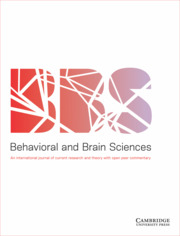Crossref Citations
This article has been cited by the following publications. This list is generated based on data provided by
Crossref.
Geary, David C
2002.
Principles of evolutionary educational psychology.
Learning and Individual Differences,
Vol. 12,
Issue. 4,
p.
317.
Pellis, Sergio M
and
Iwaniuk, Andrew N
2002.
Brain system size and adult–adult play in primates: a comparative analysis of the roles of the non-visual neocortex and the amygdala.
Behavioural Brain Research,
Vol. 134,
Issue. 1-2,
p.
31.
Holloway, Ralph L.
2002.
Brief communication: How much larger is the relative volume of area 10 of the prefrontal cortex in humans?.
American Journal of Physical Anthropology,
Vol. 118,
Issue. 4,
p.
399.
Allen, John S.
Damasio, Hanna
and
Grabowski, Thomas J.
2002.
Normal neuroanatomical variation in the human brain: An MRI‐volumetric study.
American Journal of Physical Anthropology,
Vol. 118,
Issue. 4,
p.
341.
Leiber, Justin
2002.
Philosophy, engineering, biology, and history: a vindication of Turing's views about the distinction between the cognitive and physical sciences.
Journal of Experimental & Theoretical Artificial Intelligence,
Vol. 14,
Issue. 1,
p.
29.
Wang, Samuel S.-H.
Mitra, Partha P.
and
Clark, Damon A.
2002.
How did brains evolve?.
Nature,
Vol. 415,
Issue. 6868,
p.
135.
Harrison, Kimberly H.
Hof, Patrick R.
and
Wang, Samuel S.-H.
2002.
Scaling laws in the mammalian neocortex: Does form provide clues to function?.
Journal of Neurocytology,
Vol. 31,
Issue. 3-5,
p.
289.
Buckley, Carina
and
Steele, James
2002.
Evolutionary ecology of spoken language: Co-evolutionary hypotheses are testable.
World Archaeology,
Vol. 34,
Issue. 1,
p.
26.
Geary, David C.
2003.
Evolution and development of folk knowledge: Implications for children's learning.
Infancia y Aprendizaje,
Vol. 26,
Issue. 3,
p.
287.
Fragaszy, Dorothy M.
and
Perry, Susan
2003.
The Biology of Traditions.
p.
1.
Fragaszy, Dorothy M.
Williams, Christina
Landau, Katrina
Parthasarathy, Valli
and
Davis, Tyler
2003.
An architecture for comparative cognitive development.
American Journal of Primatology,
Vol. 59,
Issue. 3,
p.
133.
Barton, Robert A.
Aggleton, John P.
and
Grenyer, Richard
2003.
Evolutionary coherence of the mammalian amygdala.
Proceedings of the Royal Society of London. Series B: Biological Sciences,
Vol. 270,
Issue. 1514,
p.
539.
Stotz, Karola C.
and
Griffiths, Paul E.
2003.
Evolutionary Psychology.
p.
135.
Dunbar, R.I.M.
2003.
The Social Brain: Mind, Language, and Society in Evolutionary Perspective.
Annual Review of Anthropology,
Vol. 32,
Issue. 1,
p.
163.
Quartz, Steven R.
2003.
Evolutionary Psychology.
p.
185.
Burish, Mark J.
Kueh, Hao Yuan
and
Wang, Samuel S.-H.
2004.
Brain Architecture and Social Complexity in Modern and Ancient Birds.
Brain, Behavior and Evolution,
Vol. 63,
Issue. 2,
p.
107.
Kubke, M. Fabiana
Massoglia, Dino P.
and
Carr, Catherine E.
2004.
Bigger Brains or Bigger Nuclei? Regulating the Size of Auditory Structures in Birds.
Brain, Behavior and Evolution,
Vol. 63,
Issue. 3,
p.
169.
Byrne, Richard W.
and
Corp, Nadia
2004.
Neocortex size predicts deception rate in primates.
Proceedings of the Royal Society of London. Series B: Biological Sciences,
Vol. 271,
Issue. 1549,
p.
1693.
Churchland, Patricia Smith
2004.
How do neurons know?.
Daedalus,
Vol. 133,
Issue. 1,
p.
42.
Oxnard, Charles E.
2004.
Brain Evolution: Mammals, Primates, Chimpanzees, and Humans.
International Journal of Primatology,
Vol. 25,
Issue. 5,
p.
1127.

